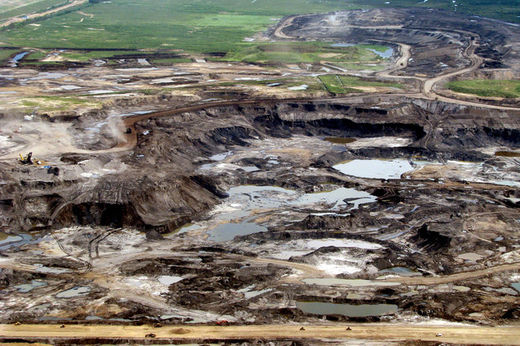
The oil sands industry is in the throes of a major expansion, powered by C$20 billion ($19 billion) a year in investments. Companies including Syncrude Canada Ltd., Royal Dutch Shell Plc and Exxon Mobil Corp. affiliate Imperial Oil Ltd. are running out of room to store the contaminated water that is a byproduct of the process used to turn bitumen -- a highly viscous form of petroleum -- into diesel and other fuels.
By 2022 they will be producing so much of the stuff that a month's output of wastewater could turn an area the size of New York's Central Park into a toxic reservoir 11 feet (3.4 meters) deep, according to the Pembina Institute, a nonprofit in Calgary that promotes sustainable energy.
To tackle the problem, energy companies have drawn up plans that would transform northern Alberta into the largest man-made lake district on Earth. Several firms have obtained permission from provincial authorities to flood abandoned tar sand mines with a mix of tailings and fresh water.
Syncrude began work this summer on Base Mine Lake, which when complete will measure 2,000 acres. It says the reservoir will eventually replicate a natural habitat, complete with fish and waterfowl. As many as 30 so-called end-pit lakes are planned, according to Alberta's Cumulative Environment Management Association, a private-public partnership.
'All Guesswork'
Green groups are alarmed. The industry's spotty environmental record drew global attention in 2008 when some 1,600 ducks died in a tailings pond belonging to Syncrude. Provincial authorities introduced regulations the next year governing the storage of fluid waste from oil sands. A June report from Alberta's energy regulator, though, said several companies aren't meeting the more stringent targets.
"There's no way to tell how the ecology of these lakes will evolve over time," says Jennifer Grant, director of oil sands at Pembina. "It's all guesswork at this point. It's reckless."
One big concern surrounding end-pit lakes is that the contaminated water will spread through the boreal ecosystem, the tract of trees and marshland that stretches around the top of the world from Canada to Russia and Scandinavia. Boreal forests store almost twice as much carbon as tropical forests.
'Russian Roulette'
In October communities bordering Canada's Athabasca River were cautioned not to drink from the waterway after a breach in a coal tailings storage pond dumped 1 billion liters (264 million gallons) of contaminated water into an area west of Edmonton.
"We're playing Russian roulette with a big part of an important ecosystem," says David Schindler, an ecology professor at the University of Alberta. "Nothing is going to grow in that soup of toxic elements except perhaps a few hydrosulfide bacteria. And all of the unforeseen events are being downplayed."
This summer, Syncrude began filling in a mine 30 miles north of Fort McMurray. Toxic slurry is being topped with fresh water from a dam to a depth of 16 feet, the level required to force tailings particles to remain at the bottom, according to Cheryl Robb, a company spokeswoman.
She says that in trials involving test ponds, Syncrude's scientists discovered naturally occurring microbes in tailings that help break down some of the pollutants. The reservoirs eventually developed ecosystems, including insects, amphibians and fish. But the largest test pond was 4 hectares -- roughly 1/200th the size of Syncrude's lake.
'We're Confident'
"The big question we have is how long will it take before the water is clean, how long is it going to take before the littoral zones develop and the shoreline vegetation builds up?" Robb says. "But we're confident in the technology."
One need not look far to see what could go wrong with this containment strategy. Some 400 miles south of Calgary lies the Berkeley Pit, a 900-foot-deep lake in Montana that began forming after copper mining ceased in 1982 and groundwater began filling the gaping hole.
The water, loaded with heavy metals and as acidic as lemon juice, now threatens to spill over into local river basins, according to the Montana Bureau of Mines and Geology.
Reclamation Strategy
Canada boasts the world's third-largest reserves of bitumen after Saudi Arabia and Venezuela. So any effort to mitigate the pollution that results from mining the fossil fuel must by necessity be grand in scope, says Dan Wicklum, chief executive of Canada's Oil Sands Innovation Alliance, an industry group based in Calgary.
"Large-scale issues require large-scale approaches," he says, adding that Cosia has encouraged technology-sharing with the goal of improving the industry's environmental record. "Companies are working together in ways the world hasn't seen."
That's precisely what's bothering one money manager.
"I'm alarmed that these companies are relying on this for a reclamation strategy," says Jamie Bonham, who's in charge of extractives research at NEI Investments in Vancouver. "We're putting a lot of eggs in one basket. Imagine the costs if it doesn't work."



Reader Comments
to our Newsletter